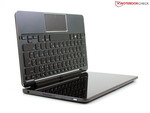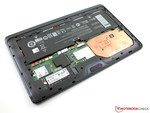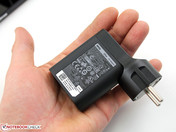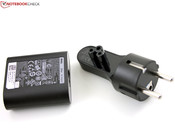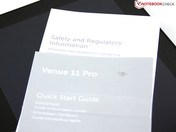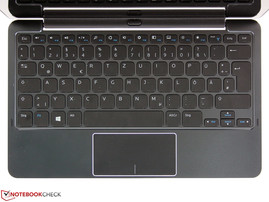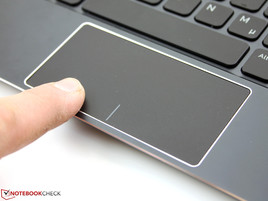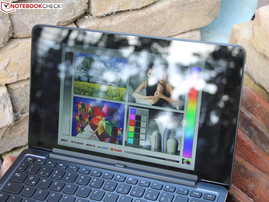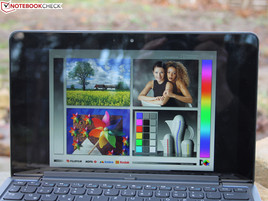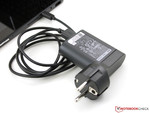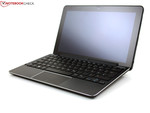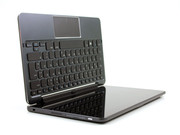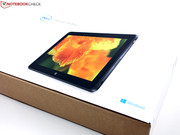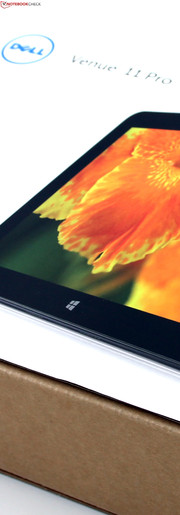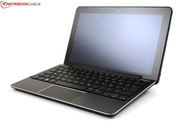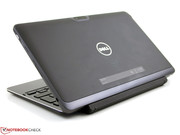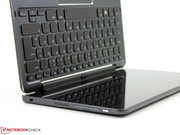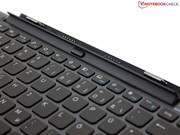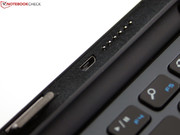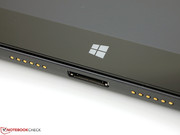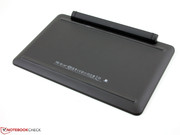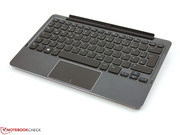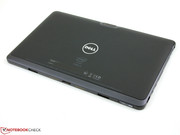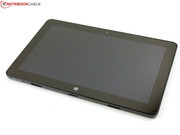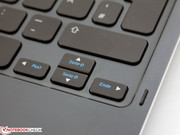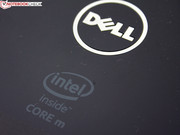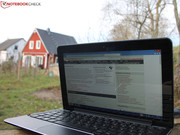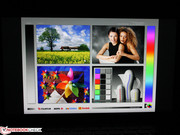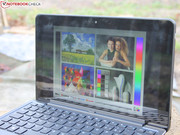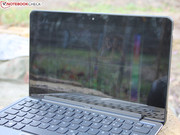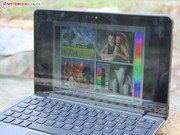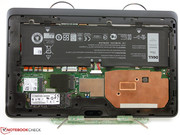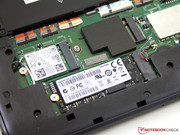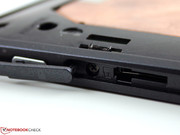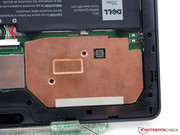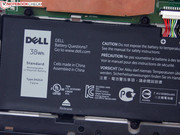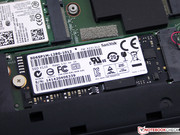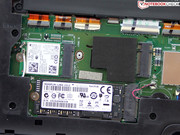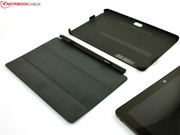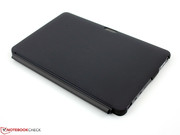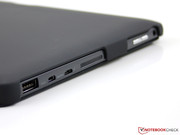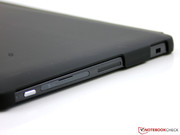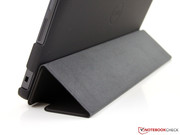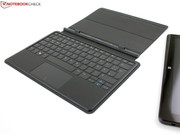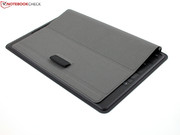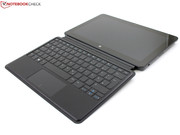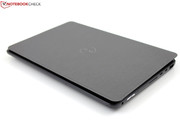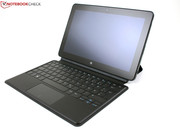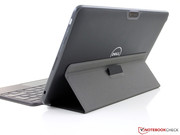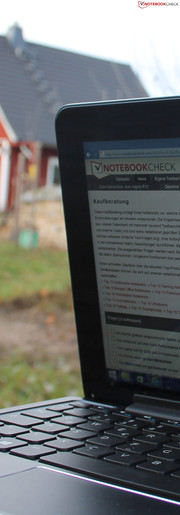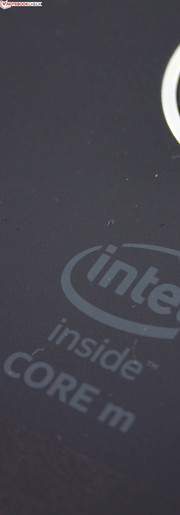Dell Venue 11 Pro 7140 Convertible Tablet Review

Manufacturers have been launching Windows tablets and convertibles in the PC market for several years now. Ever since the upsurge of low-priced tablets and smartphones, Windows-based systems have been on a downturn. Former Windows users now do most of their communication and online tasks with a tablet or phone, and put buying a PC system on the back burner. This did put the Windows World under pressure; the devices had to become more attractive.
It was not enough to simply force Windows onto a tablet. There were not enough interfaces, the performance was too low, the storage capacity was tight, and there was no decent keyboard when one was needed. The latter is especially important for business customers. We have had quite a few devices on our desk that could keep up with the performance of laptops owing to Haswell chips. However, waste heat was still an issue, and too short battery runtimes have also often been a problem. The last point now seems resolved with the economical Broadwell Core M chips: Fanless tablets with a long battery life and good performance are on the shelves.
Dell uses the sophisticated Broadwell mobile technology for its Venue 11 Pro 7140. It claims to satisfy all requirements placed on a small, portable Windows PC as a handy 10.8-inch tablet with a weight of 720 grams (~1.59 lb). The package comprised of a tablet PC keyboard, mobile version (188 Euros; ~$225 including VAT), and Dell's Venue 11 Pro (772 Euros; ~$926) has its price (960 Euros; ~$1152). In this test we will examine whether it is justified.
The top-of-the-range competitors (tablets with keyboard, 10 to 12 inches) in the business sector are Toshiba's Portégé Z10t, HP's Pro X2 410 G1, and Microsoft's Surface Pro 3. Lenovo's ThinkPad Helix would also be a rival, but the 11.6-inch device costs a whole 500 Euros (~$600) more.
· Toshiba Portégé Z10t-A2111 (11.6 inches, Haswell, starts at 770 Euros; ~$924)
· HP Pro X2 410 G1 (11.6 inches, Haswell, starts at 850 Euros; ~$1020)
· Microsoft Surface Pro 3 (12 inches, Haswell, starts at 950 Euros; ~$1140)
· HP EliteBook Revolve 810 G2 (11.6 inches, Haswell)
. Lenovo ThinkPad Helix 3G (11.6 inches, Haswell, 1450 Euros; ~$1740)
Case
The tablet unit is made of a hard plastic bezel, and the back features a rubberized plate. It can be removed for maintenance, which is a big advantage of Dell's Venue line. For this, the screw under the SD slot flap has to be removed first. The back can then be lifted off carefully with a putty knife.
The tablet's weight of 720 grams (~1.59 lb) is not more than that of the other competitors. The somewhat larger Microsoft weighs 810 grams (~1.79 lb). Our Venue 11 Pro weighs 1.4 kilograms (~3 lb) together with the travel dock including a second battery (683 grams; ~1.5 lb). The Portégé Z10t-A2111 (1.4 kilograms; ~3 lb) weighs just as much, and HP's Pro X2 410 G1 (1.6 kg; ~3.5 lb) is the heaviest.
The rigidity is quite good; the tablet can only be warped with some force using both hands. The quality makes a coherent, strong impression in the hand. Only the fingerprints on the glossy touchscreen annoyed us. Only the Z10t has a fingerprint-smudge-free zone with its anti-glare coating.
Although the same high-quality material is used for the tablet PC keyboard, it cannot quite keep up with the tablet's rigidity. The input device makes a solid impression on the desk, but not too much force should be used when typing on it. The keyboard yields slightly in the middle due to the cavity under the dock. The construction creaks and makes snapping sounds when warped with both hands. It is made of a base tray (rubberized, very slip-proof) and an aluminum upper side. The latter has been crinkled and polished on the edges for good looks.
The hinge has a tight fit on the chassis and functions as a stand that tilts the keys slightly. The tablet fits so firmly in its mount that we needed both hands for opening it. Unlike Toshiba, Dell does not rely on a U-shape socket, but on an open-back solution. The massive hinge and metal hooks prevent the tablet from rocking, which is not a matter of course for this docking design. The user can release the tablet from the keyboard by pressing a mechanical button. Fast docking without looking is possible.
Connectivity
Communication
Intel's Wireless-AC 7265 dual-band adapter that includes Bluetooth 4.0 has a very good range. The Venue 11 Pro still displayed a signal strength of 2 bars beyond our 40 meter (~131 ft) mark, and opened Notebookcheck.com with a reduced speed. Only one in every ten review sample achieves this high range in the case of the tester, and beyond his property. Our review sample is not equipped with a 3G modem, as Dell does not offer this option. There is an empty M.2 slot for inserting another device, but there are no antennas.
Security
The Venue 11 Pro is equipped with a TPM module and Intel's Anti-Theft Protection. Services like "Keep Your Hard Drive" can be selected during the ordering process. The owner can keep the SSD in case of a defect within the warranty period, and Dell installs a new one anyway (when warranty service is selected).
Accessories
Dell has plenty of accessories exclusively made for the Venue 11 in its program. The tablet PC keyboard, mobile version (with battery), that is part of this test is among them. There is also a slim alternative without a battery (tablet PC keyboard), the Tablet Folio (robust protection case, see image gallery), and the tablet docking station (170 Euros; ~$204 including VAT). The latter adds four USB 3.0 ports, and allows connecting two monitors. It also features an Ethernet port. Dell Cast is a USB flash drive that transmits the Venue 11 Pro's screen content (or even another Venue 7/8) to a TV, projector or a laptop. Finally, there is also the Active Stylus that might enable an even more precise input on the touchscreen.
Warranty
Only a one-year warranty is included as standard (collect and return). This is common among business models; the clients buy additional support services when required. For example, the three-year ProSupport and Next Business Day On-Site service is offered for an exclusive 124 Euros (~$149). There are also additional packages like the Accidental Damage Protection (75 Euros; ~$90, one year), which is basically just what the name says. Here, replacement parts are shipped or the device is sent to a repair center. Replacement of stolen parts is also included in this package.
Cameras and Microphone
2 megapixels at the front, 8 megapixels on the rear. How do both cameras perform? The 8-megapixel primary camera does its job quite well, with balanced colors and homogeneous focus. The focus only fails in closeups at a distance of less than 50 centimeters (~20 inches); the background is in focus. On the other hand, the front-facing camera could not impress us. Daylight pictures are grainy and the colors are distorted. However, it might suffice for Skype chats.
Recordings with the stereo microphone are affected by a consistent noise that sounds like a subtle rustling. However, the voice is recorded with an almost consistent volume no matter whether from a distance of 30 centimeters (~12 inches) or two meters (~6.5 ft).
Input Devices
Keyboard
The keyboard's keys are absolutely flat, but feel dull due to a light rubber coating. Thus, the fingers will find a rather unusual non-slip surface on the keys. We liked the large gaps between the keys and the standard layout with CRTL in the lower left, DEL in the upper right, and the separated arrow keys. Special keys in the first row supplement the keyboard with search, settings or screen switching. The secondary assignment mapped on the F-keys is labeled in blue.
The keys have a homogeneously firm surface that only yield when undue pressure is applied. The stroke is soft, firm, and quiet. It is absolutely possible to type on the input device in a noise-sensitive environment. The drop is relatively short and the pressure point is slightly spongy, which leads to a poor feedback for the hands. This is certainly a question of accommodation. It is nevertheless a fact that mechanical laptop keyboards, such as in the ThinkPads or Latitudes, play in a completely different league. The ThinkPad Helix sets the standard for a first-rate keyboard in the tightest of spaces. Some other competitors are also slightly better. Personal preferences will deviate at this point, and only trying out the keyboard will help here.
Touchpad
The ClickPad is slightly wider than usual, but has a soft feel and a very short drop. It has a firm stroke, clear pressure point, and the click noise is somewhere in the middle. It can be easily used as a mouse replacement.
Touchscreen
The 10-finger multi-touchscreen accepts inputs responsively up to its outer edges. Like most touchscreens, the accuracy when using a finger is very good. Even small icons on the Full HD screen are almost always hit.
Display
The 10.8-inch IPS screen (model: Dell P/N 6FR8F) with a resolution of 1920x1080 pixels corresponds to what we expect in this price range. Both the ThinkPad Helix (11.6-inches) and the Portégé Z10t (non-glare) are on par, but not so the HP's Pro X2 410 G1 (1366x768 pixels; HD). Microsoft's Surface Pro 3 has the highest resolution with 2160x1440 pixels. However, the resolution will usually be rather secondary in the business sector, especially since the resolution of the 10.8-inch device is very fine, even without a 3K screen. It has a pixel density of 204 ppi; the Surface Pro 3 has 216 ppi.
Criteria, such as the high brightness that is also available in battery mode when the user does not disable the ambient light sensor, are more important. The competitors also offer a very good brightness. We find differences mostly in the contrast where we measured 965:1. Both the ThinkPad Helix and Surface Pro 3 achieve a similar rate. HP's Pro X2 410 G1 and Portégé Z10t-A2111 clearly undercut this.
| |||||||||||||||||||||||||
Brightness Distribution: 84 %
Center on Battery: 386 cd/m²
Contrast: 965:1 (Black: 0.4 cd/m²)
ΔE Color 3.71 | 0.5-29.43 Ø5
ΔE Greyscale 5.4 | 0.57-98 Ø5.3
Gamma: 2.33
| Dell Venue 11 Pro 7140 1920x1080 IPS glare | Lenovo ThinkPad Helix 1920x1080 IPS glare | Microsoft Surface Pro 3 2160x1440 IPS glare | HP Pro X2 410 G1 1366x768 IPS glare | Toshiba Portege Z10t-A2111 1920x1080 IPS matt | |
|---|---|---|---|---|---|
| Display | |||||
| Display P3 Coverage | 46.12 | 63.6 | 46.17 | ||
| sRGB Coverage | 67.8 | 88.8 | 65.2 | ||
| AdobeRGB 1998 Coverage | 47.79 | 65.6 | 48 | ||
| Screen | 10% | -3% | -10% | -49% | |
| Brightness middle | 386 | 389 1% | 355.3 -8% | 380 -2% | 331.1 -14% |
| Brightness | 357 | 371 4% | 338 -5% | 362 1% | 315 -12% |
| Brightness Distribution | 84 | 89 6% | 91 8% | 79 -6% | 70 -17% |
| Black Level * | 0.4 | 0.41 -3% | 0.33 17% | 0.67 -68% | 0.511 -28% |
| Contrast | 965 | 949 -2% | 1077 12% | 567 -41% | 648 -33% |
| Colorchecker dE 2000 * | 3.71 | 3.12 16% | 4.72 -27% | 4.17 -12% | 14.29 -285% |
| Greyscale dE 2000 * | 5.4 | 2.79 48% | 6.53 -21% | 2.35 56% | 3.03 44% |
| Gamma | 2.33 94% | 2.17 101% | 2.35 94% | 1.96 112% | |
| CCT | 6666 98% | 6707 97% | 6883 94% | 6525 100% | |
| Color Space (Percent of AdobeRGB 1998) | 59.37 | 44 | |||
| Total Average (Program / Settings) | 10% /
10% | -3% /
-3% | -10% /
-10% | -49% /
-49% |
* ... smaller is better
We could not determine the review sample's color space. The profiling software did not function, and thus we could not calibrate the screen. The spectrophotometer determined a low DeltaE of five in the Venue 11 Pro's state of delivery. The competitors are also capable of this; all are equipped with a high-quality IPS screen.
The ambient light sensor beside the front-facing webcam automatically adapts the screen's brightness according to the light conditions. We disabled it for the battery runtime tests by turning off the energy saving functions of Intel's HD Graphics. We achieved a brightness of 150 cd/m², which we use for our measurements, by dimming the brightness six levels via the keyboard.
The insensitivity for slanted viewing angles is one of the assets of an IPS screen. The content remains legible and does not show signs of color deviations or excessively decreasing contrasts, even when looking at the screen from an almost right-angled view. The competitors are similarly strong here.
Performance
Intel's Core M-5Y10a (800 MHz) belongs to the new Broadwell architecture for high-performance Windows tablets. Its strength is the high per-MHz performance with a very low power consumption compared with the Haswell precursors. The TDP is 4.5 Watts; the comparable Core i5-4202Y forerunner still had 11.5 Watts. The integrated HD Graphics 5300 (100 to 800 MHz) now replaces the HD 4200. Data is stored on an M.2 module in the form of a Sandisk X110 SD6SP1M-128G. The user has 75 GB available; as usual, some part of the storage is reserved for the recovery partition.
Processor
Big performance differences between the Haswell Y and Core M are expected since the main goal of the Core M is energy efficiency. Nevertheless, the Cinebench scores show a processor superior to the i5-4202Y, which sometimes even manages to come close to an i7-4610Y (1.7 GHz). The latter is roughly on par in Cinebench R15 Multi.
The Venue makes use of the Turbo range of 800 to 2000 MHz when calculating on all cores only at the beginning. The clock quickly drops to 1.7 - 1.8 GHz in permanent load. A single core can, however, calculate stably with 2.0 GHz. This is also the reason for the very good CPU scores of this Core M. HP's Envy x2 15-c000ng based on the same Broadwell SoC proves that this is not the rule. It is a 15.6-inch tablet with a considerably higher passive cooling.
System Performance
Will the good computing performance be continued in application performance? PCMark 7 and 8 record very good scores that again come close to a Core i7-4619Y system (Portégé Z10t). Even the EliteBook Revolve 810 G2 with a normal Haswell ULV is almost outstripped. The Revolve's Computation score is much lower than that of the Venue 11. The i5-3317U that calculates 20% faster in the ThinkPad Helix seems more realistic, although it does not reap in a higher overall PCMark 7 score.
| PCMark 8 | |
| Home Score Accelerated v2 (sort by value) | |
| Dell Venue 11 Pro 7140 | |
| Toshiba Portege Z10t-A2111 | |
| HP EliteBook Revolve 810 G2 | |
| Work Score Accelerated v2 (sort by value) | |
| Dell Venue 11 Pro 7140 | |
| Toshiba Portege Z10t-A2111 | |
| HP EliteBook Revolve 810 G2 | |
| Storage Score (sort by value) | |
| Dell Venue 11 Pro 7140 | |
| Toshiba Portege Z10t-A2111 | |
| HP EliteBook Revolve 810 G2 | |
| Dell Venue 11 Pro 7140 HD Graphics 5300, 5Y10a, Sandisk X110 M.2 SD6SP1M-128G | Lenovo ThinkPad Helix HD Graphics 4000, 3317U, Intel SSD 525 Series SSDMCEAC180A3L | HP Pro X2 410 G1 HD Graphics 4200, 4202Y, Sandisk X110 SD6SN1M-256G-1006 | Toshiba Portege Z10t-A2111 HD Graphics 4200, 4610Y, Samsung PM851 Series MZMTE256HMHP | Microsoft Surface Pro 3 HD Graphics 4400, 4300U, Hynix HFS128G3MNM | HP EliteBook Revolve 810 G2 HD Graphics 4400, 4300U, Lite-On IT L8T-128L6G-HP | |
|---|---|---|---|---|---|---|
| PCMark 7 | -1% | 13% | 9% | 23% | 2% | |
| Score | 4135 | 4669 13% | 4095 -1% | 4973 20% | 5066 23% | 4131 0% |
| Productivity | 1913 | 2210 16% | 3344 75% | 2455 28% | 2500 31% | |
| Creativity | 7755 | 3241 -58% | 7560 -3% | 3564 -54% | 7503 -3% | |
| Computation | 11986 | 14545 21% | 10851 -9% | 17586 47% | 9390 -22% | |
| System Storage | 5011 | 5167 3% | 5204 4% | 5313 6% | 5331 6% | |
| PCMark 8 | -0% | 4% | ||||
| Home Score Accelerated v2 | 2480 | 2282 -8% | 2394 -3% | |||
| Work Score Accelerated v2 | 3291 | 3441 5% | 3711 13% | |||
| Storage Score | 4841 | 4939 2% | 4927 2% | |||
| Total Average (Program / Settings) | -1% /
-1% | 13% /
13% | 5% /
6% | 23% /
23% | 3% /
3% |
| PCMark 7 Score | 4135 points | |
| PCMark 8 Home Score Accelerated v2 | 2480 points | |
| PCMark 8 Work Score Accelerated v2 | 3291 points | |
Help | ||
Storage Devices
The Sandisk X110 M.2 with a gross capacity of 128 GB has already delivered an impressive storage score in the above System scores. However, they are not the greatest sequential read and write rates in detail, regardless of whether large or the smallest blocks (e.g. 4 K read/write) are being read or written. This becomes clear in a total score of 648 points in AS SSD, which is 9 to 57% less than Intel's SSD 525, Samsung's PM851 or Hynix' HFS128G3MNM. HP's Pro X2 410 G1, also with a Sandisk X110 (mSATA), achieved better rates.
| Dell Venue 11 Pro 7140 Sandisk X110 M.2 | Lenovo ThinkPad Helix Intel SSD 525 Series | HP Pro X2 410 G1 Sandisk X110 | Toshiba Portege Z10t-A2111 Samsung PM851 Series | Microsoft Surface Pro 3 Hynix HFS128G3MNM | |
|---|---|---|---|---|---|
| CrystalDiskMark 3.0 | 25% | 60% | 68% | 61% | |
| Read Seq | 395.6 | 447 13% | 499.3 26% | 522 32% | 501 27% |
| Write Seq | 221.9 | 260.2 17% | 426.3 92% | 263.2 19% | 324 46% |
| Read 512 | 209.1 | 362.1 73% | 286.3 37% | 423.8 103% | 357.8 71% |
| Write 512 | 153.5 | 253.8 65% | 371 142% | 263.5 72% | 324.6 111% |
| Read 4k | 22.9 | 18.54 -19% | 30.78 34% | 36.08 58% | 20.81 -9% |
| Write 4k | 35.29 | 42.34 20% | 70.4 99% | 93.6 165% | 76.2 116% |
| Read 4k QD32 | 256.4 | 222.6 -13% | 313.2 22% | 390.9 52% | 345 35% |
| Write 4k QD32 | 156.1 | 219.4 41% | 202.4 30% | 228.1 46% | 294.4 89% |
| AS SSD | -0% | 66% | 54% | ||
| Seq Read | 405.4 | 466.4 15% | 512 26% | 493.7 22% | |
| Seq Write | 134.7 | 249.2 85% | 250.3 86% | 303 125% | |
| 4K Read | 19.3 | 17.81 -8% | 32.51 68% | 22 14% | |
| 4K Write | 33.22 | 37.3 12% | 84.4 154% | 73.7 122% | |
| 4K-64 Read | 242 | 221.4 -9% | 371.5 54% | 358.3 48% | |
| 4K-64 Write | 152.5 | 217.1 42% | 220.9 45% | 215 41% | |
| Access Time Read * | 0.16 | 0.193 -21% | 0.071 56% | 0.087 46% | |
| Access Time Write * | 0.104 | 0.276 -165% | 0.039 62% | 0.075 28% | |
| Score Read | 302 | 286 -5% | 455 51% | 430 42% | |
| Score Write | 199 | 279 40% | 330 66% | 319 60% | |
| Score Total | 648 | 706 9% | 1016 57% | 965 49% | |
| Total Average (Program / Settings) | 13% /
10% | 60% /
60% | 67% /
67% | 58% /
57% |
* ... smaller is better
Graphics Card
The HD Graphics 5300 (100 - 800 MHz) can clock even slower while idling than its HD 4200 precursor. Its scores in the 3D benchmarks are approximately 10 - 15% better than with the HD, for example in the Z10t. The IGP moves on an overall very low level, which a Haswell HD 4400 (Surface Pro 3, Revolve 810) can just outperform (~20%).
| 3DMark | |
| 1280x720 Ice Storm Standard Score (sort by value) | |
| Dell Venue 11 Pro 7140 | |
| Lenovo ThinkPad Helix | |
| Toshiba Portege Z10t-A2111 | |
| Microsoft Surface Pro 3 | |
| HP EliteBook Revolve 810 G2 | |
| 1280x720 Ice Storm Standard Graphics (sort by value) | |
| Dell Venue 11 Pro 7140 | |
| Lenovo ThinkPad Helix | |
| Toshiba Portege Z10t-A2111 | |
| HP EliteBook Revolve 810 G2 | |
| 1280x720 Cloud Gate Standard Score (sort by value) | |
| Dell Venue 11 Pro 7140 | |
| Lenovo ThinkPad Helix | |
| Toshiba Portege Z10t-A2111 | |
| Microsoft Surface Pro 3 | |
| HP EliteBook Revolve 810 G2 | |
| 1280x720 Cloud Gate Standard Graphics (sort by value) | |
| Dell Venue 11 Pro 7140 | |
| Lenovo ThinkPad Helix | |
| Toshiba Portege Z10t-A2111 | |
| HP EliteBook Revolve 810 G2 | |
| 3DMark 11 Performance | 883 points | |
| 3DMark Ice Storm Standard Score | 38912 points | |
| 3DMark Cloud Gate Standard Score | 3484 points | |
| 3DMark Fire Strike Score | 466 points | |
Help | ||
Gaming Performance
Apart from browser games and those from the Windows Store, gaming is rather limited to older games like Risen Part 1 from 2009. However, even this game is at most playable in medium details, which means 1024x768 pixels. Performance is about 16 to 60% over an HD 4200. The HD 5300 produces 5 to 25% more frames.
| Risen | |
| 800x600 all off/low AF:0x (sort by value) | |
| Dell Venue 11 Pro 7140 | |
| Acer Aspire Switch 11 Pro 128GB HDD-Dock | |
| Toshiba Satellite U50t-A-100 | |
| 1024x768 all on/med AF:2x (sort by value) | |
| Dell Venue 11 Pro 7140 | |
| Acer Aspire Switch 11 Pro 128GB HDD-Dock | |
| Toshiba Satellite U50t-A-100 | |
| Sleeping Dogs - 1024x768 Low Preset AA:Normal (sort by value) | |
| Dell Venue 11 Pro 7140 | |
| Sony Vaio Duo 13 SVD1321M2E | |
| Fujitsu Lifebook U574 | |
| Middle-earth: Shadow of Mordor - 1280x720 Lowest Preset (sort by value) | |
| Dell Venue 11 Pro 7140 | |
| Acer Aspire Switch 11 Pro 128GB HDD-Dock | |
| Fujitsu Lifebook U574 | |
| low | med. | high | ultra | |
| Risen (2009) | 60 | 22.7 | 16 | |
| Sleeping Dogs (2012) | 21.3 | 14.1 | 7.1 | |
| Middle-earth: Shadow of Mordor (2014) | 16.65 | 9.27 | 5 |
Emissions
System Noise
Owing to the very low TDP, the OEMs can design Intel's Core M systems without a fan because passive cooling is possible with little effort. Our screenshots of the opened Venue 11 Pro show a massive copper plate over the SoC. HP's Pro X2 410 G1 Haswell system was also fanless, unlike the Portégé Z10t, Surface Pro 3, and ThinkPad Helix. The first two in particular produced high noise during load (41 and 44 dB(A)). Although the ThinkPad Helix was very quiet, it reached temperatures of up to 67 degrees Celsius.
Temperature
The advantage of Broadwell SoCs becomes most evident in waste heat. Active cooling was normally used for Haswell, which produced noise, but usually kept the temperatures very low (Z10t). However, low temperatures are also possible without a fan in Haswell systems with well-solved thermals, e.g. HP's Pro X2 410 G1. Our Venue 11 Pro ranges in the middle. It did not reach extreme temperatures even in the stress test (47 degrees Celsius; ~117 °F), and the hottest spot was 33 degrees Celsius (~91 °F) while idling.
The Venue 11 Pro's CPU performed the stress test with 900 to 1000 MHz, and its GPU with 500 MHz. Both components were throttled since they have to share the low TDP. The HD 5300's clock climbed to 600 MHz when we turned off the CPU part of the test. On the other hand, i.e. running Prime95 alone, the processor clocked with 1.7 to 1.9 GHz. A benchmark performed directly afterward resulted in the same scores as in a cold start. The SoC heated up to 90 degrees Celsius (~194 °F), but settled to around 88 degrees (~190 °F) in the stress test.

| Dell Venue 11 Pro 7140 HD Graphics 5300, 5Y10a, Sandisk X110 M.2 SD6SP1M-128G | Lenovo ThinkPad Helix HD Graphics 4000, 3317U, Intel SSD 525 Series SSDMCEAC180A3L | HP Pro X2 410 G1 HD Graphics 4200, 4202Y, Sandisk X110 SD6SN1M-256G-1006 | Toshiba Portege Z10t-A2111 HD Graphics 4200, 4610Y, Samsung PM851 Series MZMTE256HMHP | Microsoft Surface Pro 3 HD Graphics 4400, 4300U, Hynix HFS128G3MNM | HP EliteBook Revolve 810 G2 HD Graphics 4400, 4300U, Lite-On IT L8T-128L6G-HP | |
|---|---|---|---|---|---|---|
| Heat | -23% | 6% | -2% | -4% | 7% | |
| Maximum Upper Side * | 46.3 | 55.7 -20% | 38.6 17% | 39.8 14% | 45.2 2% | 42.6 8% |
| Maximum Bottom * | 47 | 67.1 -43% | 41.5 12% | 39.4 16% | 46.4 1% | 40.2 14% |
| Idle Upper Side * | 30.6 | 35 -14% | 33.3 -9% | 38.6 -26% | 35.2 -15% | 30.4 1% |
| Idle Bottom * | 33.3 | 37.7 -13% | 31.6 5% | 36.6 -10% | 34.4 -3% | 31.8 5% |
* ... smaller is better
(-) The maximum temperature on the upper side is 46.3 °C / 115 F, compared to the average of 35.3 °C / 96 F, ranging from 19.6 to 55.7 °C for the class Convertible.
(-) The bottom heats up to a maximum of 47 °C / 117 F, compared to the average of 36.8 °C / 98 F
(+) In idle usage, the average temperature for the upper side is 28.7 °C / 84 F, compared to the device average of 30.2 °C / 86 F.
(±) The palmrests and touchpad can get very hot to the touch with a maximum of 36.4 °C / 97.5 F.
(-) The average temperature of the palmrest area of similar devices was 28.1 °C / 82.6 F (-8.3 °C / -14.9 F).
Speakers
The stereo speakers are positioned on the Venue 11 Pro's left and right so that they are normally not covered when holding the device. Their maximum volume is quite impressive, and the sound remains free of distortions or crackling even at maximum volume. The speakers are quite suitable for listening to music. Although they lack bass, the mids and trebles are acceptably differentiated.
Energy Management
Power Consumption
The power consumption is low in the category comparison. There are differences with Haswell particularly while idling. Just two Watts are consumed in minimum brightness. A Haswell-Y has never before been so frugal. On the other hand, the load power consumption has increased by 30%. The handy power supply recharges the tablet's battery via micro-USB. The disadvantage of this is the low charging current and thus very long charging time of almost six hours (tablet and dock battery).
| Dell Venue 11 Pro 7140 HD Graphics 5300, 5Y10a, Sandisk X110 M.2 SD6SP1M-128G | Lenovo ThinkPad Helix HD Graphics 4000, 3317U, Intel SSD 525 Series SSDMCEAC180A3L | HP Pro X2 410 G1 HD Graphics 4200, 4202Y, Sandisk X110 SD6SN1M-256G-1006 | HP EliteBook Revolve 810 G2 HD Graphics 4400, 4300U, Lite-On IT L8T-128L6G-HP | Toshiba Portege Z10t HD Graphics 4000, 3339Y, Toshiba THNSNF256GMCS | |
|---|---|---|---|---|---|
| Power Consumption | -120% | -19% | -11% | -52% | |
| Idle Minimum * | 2 | 7.9 -295% | 4.1 -105% | 2.1 -5% | 5.2 -160% |
| Idle Average * | 5.9 | 10.3 -75% | 7.4 -25% | 4.4 25% | 6.8 -15% |
| Idle Maximum * | 6.2 | 11.5 -85% | 7.4 -19% | 4.6 26% | 8.6 -39% |
| Load Average * | 19.1 | 29.2 -53% | 13.5 29% | 24.7 -29% | 20.8 -9% |
| Load Maximum * | 18.2 | 34.6 -90% | 13.2 27% | 31.1 -71% | 24.5 -35% |
* ... smaller is better
| Off / Standby | |
| Idle | |
| Load |
|
Battery Runtime
The battery life of 9:22 hours of the dock and the Wi-Fi test outruns the entire competition. The tablet lasted for 358 minutes in the Wi-Fi test without the dock. That is almost six hours. The first Venue 11 Pro that we tested (Core i3-4020Y) managed 6:42 hours in the Wi-Fi test, and achieved an idle runtime of 12:42 hours. Although the runtime has apparently decreased, the computing power has increased. The Venue 11 Pro 7130 (i5-4300Y) only manages 4:40 hours in this test compared to 4:04 hours in the Broadwell-equipped Pro 7140.
Verdict
Good gets even better? While Dell's Venue 11 Pro 7130 (Haswell i5) was almost penalized with a rating of 78% in the tablet sector, the Venue 11 Pro 7140 Broadwell update (Core M-5Y10a) reaps in more points. We tested it as a convertible alongside its keyboard dock, which we believe does the 10.8-inch device most justice.
Dell wanted to create a handy Windows office device, and achieved its goal. Long battery runtimes in conjunction with good computing performance, maintenance options, extensive productivity accessories, decent camera, silent operation, and a very good IPS screen in Full HD. The only real point of criticism that we have relates to the keyboard, which has an undefined pressure point.
In the intro we asked: Venue 11 Pro (7140) with travel keyboard: Will the Broadwell tablet make a subnotebook superfluous? This is in fact the case. We can reward the Venue 11 Pro with an outstanding performance score (compared with subnotebooks, Haswell tablets). The little tablet based on the fanless Broadwell architecture reaped in scores that can often compete with the best Haswell tablets from the recent past. Dell has every conceivable accessory that predestines the Venue 11 Pro as the sole PC for everyday work with different keyboards, a tablet stand (supports two monitors), and digitizer.
The competitors in the 770 to 1000 Euro (~$924 - ~$1200) price range all have shorter runtimes. The build of Toshiba's Portégé Z10t is not as good, but it has a superior keyboard. Like the Toshiba, the HP Pro X2 410 G1 has a good keyboard and despite Haswell is passively cooled. We complained about the screen's tight opening angle. The Surface Pro 3 features the best build, but it is doubtful whether business users will want to get used to the cramped keys of the Type 2 Cover. The tester gave Surface Pro's input devices the better rating, though. The integrated stand also allows a flatter and much more agreeable opening angle for typing.


 Deutsch
Deutsch English
English Español
Español Français
Français Italiano
Italiano Nederlands
Nederlands Polski
Polski Português
Português Русский
Русский Türkçe
Türkçe Svenska
Svenska Chinese
Chinese Magyar
Magyar